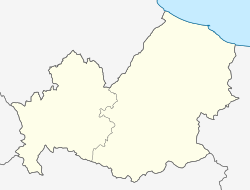Pesche
Pesche
Pesche | |
|---|---|
| Comune di Pesche | |
| Coordinates: 41°37′N 14°17′E / 41.617°N 14.283°E | |
| Country | Italy |
| Region | Molise |
| Province | Province of Isernia (IS) |
| Area | |
| • Total | 12.7 km2 (4.9 sq mi) |
| Population (Dec. 2004)[2] | |
| • Total | 1,459 |
| • Density | 110/km2 (300/sq mi) |
| Time zone | UTC+1 (CET) |
| • Summer (DST) | UTC+2 (CEST) |
| Postal code | 86090 |
| Dialing code | 0865 |
Pesche is a comune (municipality) in the Province of Isernia in the Italian region Molise, located about 30 kilometres (19 mi) west of Campobasso and about 5 kilometres (3 mi) northeast of Isernia. As of 31 December 2004, it had a population of 1,459 and an area of 12.7 square kilometres (4.9 sq mi).[3]
Pesche borders the following municipalities: Carpinone, Isernia, Miranda, Sessano del Molise.
History
Classical Age
The history of the land where Pesche was born is tied to the history of Isernia (its capitol). With the renaissance of the city under the rule of Nero and Trajan and the presence of a natural hot spring, gave way to the birth to the thermal baths and the “Santuario di Santa Maria del Bagno”.
Medieval Times
With the end of imperial authority in the West, and the fall of big cities, along with the arrival of new populations that governed the Italian peninsula (Eruli, Goti, Longobardi), a sudden migration away from the big cities occurred. It’s exactly during this time that, close to the thermal bath’s, a small group of people will move to the base of Monte San Marco around the year 1000. A Benedictine monastery was already present here which was most likely built on an small Sunni fortress which was then used as a look out post. The population grew bigger and they started settling in the town by building several important structures. The presence of the Benedictine monks is very important to the town of Pesche, as they incentivized the building of places of worship and the cultivation of a pious lifestyle, so much so that the citizens of Pesche were known as “monastic”. The most important religious structures that were build were the church of Sant’Angelo, the Santa Maria dell’ospedale (where they also managed a hospice) and the convent of Santa Croce. Its interesting to note how the church of Sant’Angelo (the parochial church at the time) was not build inside the walls of the city but further up in the hills. During this time the center and the houses of its inhabitants were also being built further up the valley and outside of the city walls. The political situation was also changing and Pesche became an important possession of the Monastery of Montecassino, so much so that at the time it also had papal protection.
Modern Times
In 1956 a violent Earthquake destroyed a the majority of the town, forcing the monks who stayed to return to Montecassino. During that time there was also a plague, perhaps a contagious flu, that delayed the speed of reconstruction. In 1593 a church was built that was dedicated to San Benedetto and Santa Scolastica, on which the church that stands there today was erected as the other was also severely damaged due to another earthquake in the XVIII century.
The 1900's
During WWI the citizens of Pesche also went out to fight, and a statue in their honor was built in April of 1920, the first in all of Molise. During that time the biggest influence on the town was religion and the church lead by the Archpriest don Zeffirino Petrecca who fought to maintain things as they were during his time in power and keep to the origins and traditions of the town. In the 1950’s several trees were planted in the hills which today make up the Pine forest, which function as a fortress for the unstable stones around the town that are sedimentary and are on a clayish terrain. From the 80’s there is an expansion of the town in the lower part, where people have started to live, abandoning the history center.
Demographic evolution

Sister city
![]() Woodstock, Ontario, Canada[4]
Woodstock, Ontario, Canada[4]
References
- ^ "Superficie di Comuni Province e Regioni italiane al 9 ottobre 2011". Italian National Institute of Statistics. Retrieved 16 March 2019.
- ^ "Popolazione Residente al 1° Gennaio 2018". Italian National Institute of Statistics. Retrieved 16 March 2019.
- ^ All demographics and other statistics: Italian statistical institute Istat.
- ^ https://www.cityofwoodstock.ca/en/city-governance/sister-cities.aspx



